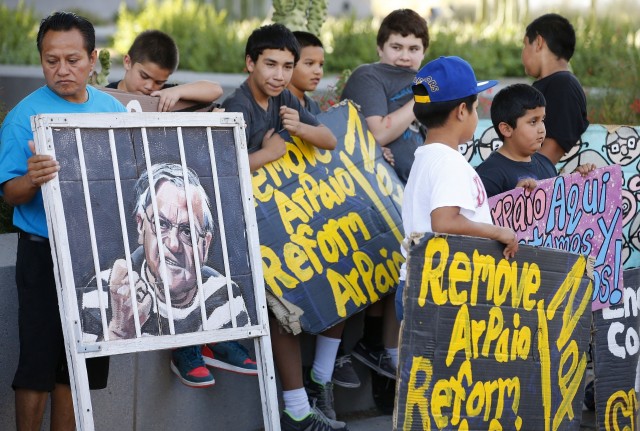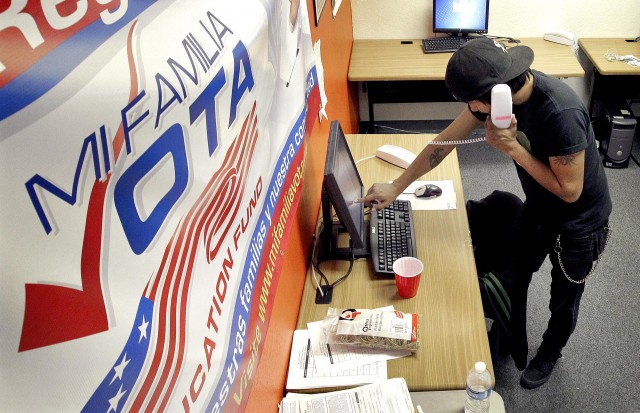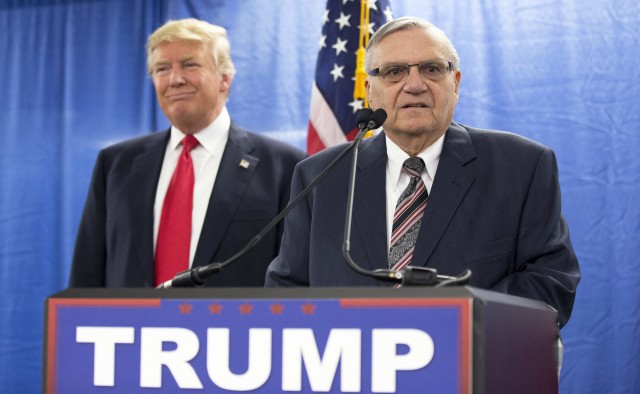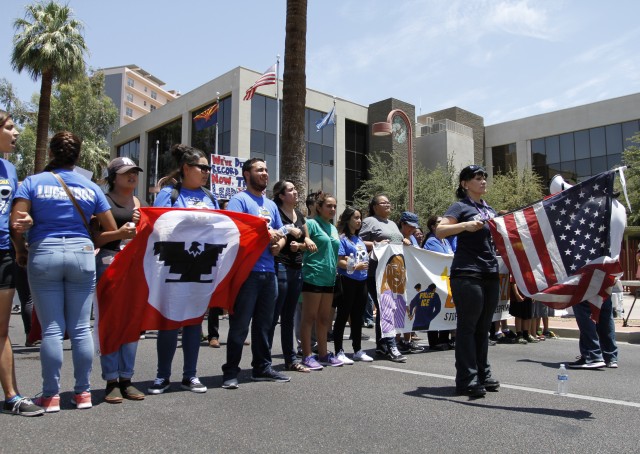Arizona's Blue Horizons

This article appears in the Summer 2016 issue of The American Prospect. Subscribe here.
Six years ago, as a response to a repressive anti-immigrant law, Silvana Salcido Esparza, who owns the popular Mexican restaurant Barrio Café near downtown Phoenix, began the Calle 16 mural project. Artists from the area came together to paint murals showcasing Mexican and Arizonian pride. Now, artists in Phoenix are poised to do the same thing in response to Donald Trump. In March, a famous anonymous street artist known as El Peezo resurfaced after almost two years of absence to paint a mural depicting Trump as Jabba the Hutt—the slug-like alien from the Star Wars film franchise—in the heart of Phoenix. (The mural has since been removed.)
As a normally red state that borders Mexico, with a growing Latino population, Arizona is a breeding ground for both Trumpism and for the backlash against him. The state is an extreme case of the polarization afflicting America. Some white people resent the growing presence of Latinos, while immigrants, undocumented or not, are justifiably anxious. In his speech announcing his intention to run for president, Trump set the tone for his campaign by implying that Mexican immigrants crossing the border were largely criminals and rapists.
But before there was Donald Trump, there was Joe Arpaio, the sheriff of Arizona’s largest county, Maricopa, which encompasses Phoenix and its suburbs. Arpaio, who styles himself as “America’s Toughest Sheriff,” is flagrantly anti-immigrant. The sheriff, first elected in 1992, has been embroiled in numerous controversies about racial profiling and the treatment of inmates at the Maricopa County jails. Lawsuits against him and the Maricopa County Sheriff’s office have cost the county more than $140 million, and he was found in civil contempt of court in May 2016 for ignoring a judge’s order to cease racial profiling. Unsurprisingly, Sheriff Arpaio welcomed the Trump candidacy with open arms.
For all the negative attention he brought to the state, Latino groups do credit Arpaio with boosting Latino political participation. In the midterm cycles between 2002 and 2014, Latino voter registration grew by 165 percent. If these trends continue, the Latino voting bloc could become a powerhouse statewide. “It could mean something like one million Latino voters in Arizona,” says Antonio Gonzalez, the president of the Southwest Voter Registration Education Project (SVREP).

AP Photo/Ross D. Franklin Protesters rally outside the office of Sheriff Joe Arpaio, who violated a judge's order to end racial profiling.
Trump’s egregious hostility to not just undocumented immigrants but Latinos in general is certain to increase Latino turnout this year in Arizona. But by how much, and by what mechanisms?
EVEN WITHOUT AN INTENSIFIED mobilization effort, demographic shifts work in favor of increased Latino voting participation. The Latino share of Arizona’s population nearly doubled from about 16 percent in 1980 to 31 percent today, and their numbers are growing faster than non-Latinos. They represent 22 percent of eligible voters statewide, a figure that will also grow.
The gap between the population share and the percentage of eligible voters reflects the fact that only about 48 percent of Latinos in Arizona are citizens. Some are undocumented, but hundreds of thousands are eligible to vote or are legal residents eligible to naturalize. For Latinos, the political challenge is to increase naturalization, voter registration, and turnout. According to the William C. Velasquez Institute, turnout among registered Latino voters in Arizona in 2012 was 77.5 percent, up from 71 percent in 2008, but still well behind the white turnout rate of nearly 87 percent.
“I would expect that number to get bumped up,” says Gonzalez. “Maybe you’ll get 80 percent of registered voters, which would be very high for Arizona Latinos,” he predicts. “All of this is because of Trump. He will excite people. Just not the way he wants.” SVREP has launched a Fight the Wall campaign with an online registration push where potential voters can download a free smartphone application and register to vote.
Although turnout climbed between the last two presidential elections, nearly half a million Latino citizens were not registered to vote. Only about 52 percent of eligible Latinos were registered in both the last two presidential elections, well below the white rate of just under 70 percent. One indicator of increasing Latino engagement is early registration. In 2010, according to The New York Times, 91,000 Arizona Latinos were registered to vote by mail. Today that number has grown to more than 300,000.
Arizona has been a solidly red state in recent presidential elections. The last time Arizonians voted for a Democrat was in 1996, in Bill Clinton’s re-election campaign. Before that, Harry Truman was the last Democrat to carry the state, in 1948. However, five of the last ten governors have been Democrats, most recently Janet Napolitano, who served from 2003 to 2009.
Gonzalez compares the potential impact of Trump in Arizona to Proposition 187 in California, a ballot initiative promoted in 1994 by Governor Pete Wilson to deprive undocumented immigrants of basic public services. The initiative pushed Latinos solidly into the Democratic camp and increased political mobilization and turnout. California has been a reliably blue state ever since. “I’ve been saying Arizona is the next purple state. Everyone told me I was crazy!” Gonzalez says with a laugh.
Immigrant advocates say a state law passed in 2010, S.B. 1070, is reminiscent of Prop 187 in California. First introduced in the Arizona State Senate, the law made it a misdemeanor for an immigrant to be in the state without carrying proper registration and identification. More ominously, the law also requires law enforcement officials to determine a person’s immigration status during police stops when there is “reasonable suspicion” that he is or she is an undocumented immigrant. The Latino community and immigrant-rights advocates were quick to point out that this was racial profiling.

AP Photo/Matt York Latino activists hope to increase Hispanic voting turnout to 80 percent this year.
According to Raquel Terán, the Arizona state director for Mi Familia Vota, which promotes Latino political participation, “One of the reasons we had S.B. 1070 is because Latinos were not part of the decision-making process.” In 2010, the Republicans held a supermajority in the Arizona State Senate. Shortly after S.B. 1070 passed, Mi Familia Vota and other Latino organizations came together to form One Arizona, an alliance of groups that would work within marginalized communities in the state.
One of Mi Familia Vota’s primary functions is helping immigrants with the naturalization process and holding voter registration drives. At workshops sponsored by the group, lawyers explain the process to potential citizens and Mi Familia Vota sends them off with study materials.
At MFV’s citizenship workshops, the organization and volunteers help immigrants fill out the required forms. The group tries to follow up with those who came to the forums and took their application materials home. “We assisted more than 1,500 folks in the last four months,” Terán reports.
To promote voter registration, “We visit high-traffic areas like the Motor Vehicle Division, libraries, supermarkets, and soccer tournaments,” Terán says. MVF also held registration drives at a Cinco De Mayo festival and at high schools. “We registered over 1,000 high school students in Phoenix and Tuscon,” she adds.
“Trump has been a motivator. They’ve been motivated by his rhetoric.”
U.S. Citizenship and Immigration Services estimates that it can take six months or more to process naturalization applications. So applicants who hope to vote in November need to have their applications in process by now. Terán explains that the people who come to Mi Familia Vota for help with the citizenship process are always energized in an election year, but this year is different. “A lot of the folks that came in wanted to be ready in November,” she says. “Trump has been a motivator. They’ve been motivated by his rhetoric.”
A complication, however, is that Latinos tend to be somewhat skeptical of both political parties. While there is appreciation for President Obama’s efforts to suspend deportation of undocumented immigrants who were brought to the United States as children, many Latinos resent the intensified immigration enforcement directed at others. Since Obama took office in January 2009, the U.S. has deported more than 2.5 million immigrants.
In the summer of 2014, when young children from Central America were fleeing the violence of their home countries, they were not treated as refugees and many were deported, despite the Obama administration knowing that some of them could be facing death.
Some of the children who made it across the border into Texas were then bused to Arizona and held in detention centers. The executive director of the Arizona AFL-CIO, Rebekah Friend, is passionate when she speaks of the child migrants she tried to help. “They had nothing—some of them didn’t even have toothbrushes,” says Friend. “All that happened under Obama.”

AP Photo/Mary Altaffer Maricopa County's notoriously anti-immigrant Sheriff Joe Arpaio welcomed the Trump candidacy with open arms. Here, Arpaio joins Trump for a news conference in Marshalltown, Iowa, on January 26, 2016.
That same year, Janet Murguía, head of the National Council of La Raza, a Latino civil-rights group, began calling Obama the Deporter-in-Chief. The president appeared to making inroads with the Latino community when he issued an executive order that would stop the removal of undocumented immigrants who hadn’t broken any other laws. But then in early 2016, immigration raids resumed—this time targeting the refugees from Central America.
“In my fantasy world,” says Friend, the risk of Trump “makes everybody stand up and run to the polls. But the reality of it is are so disengaged from the political process.” Latinos haven’t been harnessing their electoral power because “both parties have a tendency to pander to groups and not address the real issues,” she adds.
“ don’t feel as if the Democrats have really stood up for them on immigration reform,” says Friend. Comprehensive immigration reform has been a political hot button for decades, but neither party has taken steps to address the issue in any real substantial way.
ANOTHER ARIZONA TRUMP CASUALTY could be Republican Senator John McCain, who has been whipsawed by the GOP candidate’s campaign. Trump insulted McCain’s iconic status as a war hero, saying he “liked people who weren’t captured” in reference to McCain’s time as a prisoner of war in Vietnam. Trump has never served in the military. Yet today, McCain says he is supporting Trump.
Despite that support, many Trump supporters view the senator as the type of establishment Republican rejected by the Tea Party right, so McCain stands to lose support from both Trump backers and the anti-Trump camp.
McCain is facing formidable challengers both in the Republican primary and from Democratic Representative Ann Kirkpatrick, whom he will face in the November election if he survives the August primary. A May 2016 Public Policy Polling survey found that McCain had a 50 percent disapproval rating, and showed him tied with GOP primary challenger Kelli Ward. The poll also showed McCain leading Kirkpatrick by just six points, and 39 percent of respondents said they were less likely to support a Senate candidate who backed Trump.
McCain remains the favorite, but considers this election “the race of my life.” If Latino turnout surges, Democrats could take an Arizona Senate seat for the first time in two decades. The state’s last Democratic senator, Dennis DeConcini, was first elected in 1976, won re-election three times, and retired in 1995.
Rumors about Hillary Clinton’s running mate began circulating almost as soon as it became clear she would become the Democratic nominee. Among the rumored vice presidential candidates were two influential Latino men: Julián Castro and Thomas Perez. Castro was the mayor of San Antonio, Texas, from 2009 to 2014 until Obama tapped him to be secretary of Housing and Urban Development. Perez was serving as an assistant attorney general for civil rights until joining Obama’s cabinet as the secretary of labor in 2013.

AP Photo/ Beatriz Costa-Lima Activists block a major downtown road to protest a Supreme Court decision on immigration Thursday June 23, 2016, in Phoenix. The crowed gathered outside the U.S. Immigration and Customs Enforcement building in Phoenix to voice dismay at the Supreme Court decision blocking President Barack Obama's plan to shield millions living in the U.S. illegally from deportation.
Presumably, picking a Latino as her running mate would galvanize voters and increase turnout, but that line of thinking may be too simplistic. “A Latino last name is not going to trick anybody,” says Raquel Terán. “Our electorate has matured a lot.” Arizona State Representative Juan Mendez also has his doubts. “It wouldn’t be a clincher,” he says.
“I think we have the ability to do it, but is the will there to do it?” asks Friend about getting Latino turnout high enough to stop Trump. Despite her concerns, she is still working to make sure her union members get to the polls in November. “For most labor , the idea of a Trump presidency is frightening,” she says. “We’ve been trying to move our members to vote early,” she explains. “You don’t get hit with as much garbage” before the last few weeks of the election season, when the advertisements get overwhelming.
Friend says that, alongside registration drives, the Arizona AFL-CIO stresses education and making sure people actually go to the polls. “You can register as many people as you want, but the more important piece for me is getting them to the ballot box,” she says. “Sometimes, in the flurry to up registration numbers, we forget about that piece.”
AS IN OTHER REPUBLICAN-LED states, Arizona turnout could be held down by voter-suppression maneuvers. Arizona is one of 11 states with strict voter-ID laws. In the state’s March presidential primary, Arizonians reported standing in long lines for up to five hours. There were reports of the mishandling of voter registration cards, in which voters were mysteriously switched from Democratic to independent, thus denying them the right to vote in the state’s closed primary.
There was also a drastic cut in the number of polling places, especially in heavily Latino areas. In Maricopa County, which is just under 30 percent Latino, voting locations were cut from 200 to just 60 before the primary. In heavily Latino South Phoenix, the last ballot at South Mountain Community Center, the community’s only polling place, was cast at 12:12 a.m. on Wednesday morning. Affluent areas reported much shorter lines and wait times.
“In my district, you had access to three, if not four, polling locations,” says Juan Mendez, who represents District 26 in the Arizona House. But things were drastically different in the heavily Latino West Valley region. “There were entire districts in West Valley that had no polling locations,” he says.
Despite the chaos of the presidential primary, Mendez is still optimistic about the general election in November. “We have a lot of initiatives,” he says of the ballot. Not only will Arizonians be voting for president and senator, but they can expect to vote on the legalization of marijuana, on raising the minimum wage to $12 by 2020, and on strengthening their public campaign-finance system. “That’s a lot of stuff that is going to turn out voters and young voters, too,” Mendez says. From an organizing standpoint, Mendez sees great value in Kirkpatrick’s campaign for U.S. Senate. “They [Kirkpatrick’s campaign] have done a great job; they scooped up all of our young organizers around the colleges.”
Despite gerrymandering, the Arizona legislature has already been becoming less overwhelmingly Republican. After the 2010 election, Republicans enjoyed an advantage over Democrats of 21 to 9 in the Arizona State Senate and 40 to 20 in the House. Today, that majority has been cut to 18 to 12 in the senate and 36 to 24 in the House. Mendez, who is currently running for state senate, thinks the Democrats have a shot this year at making the senate an even 15 to 15.
It may take a few more elections before Arizona can be counted as purple, if not potentially blue. But politicians like Joe Arpaio and Donald Trump are certainly helping the process along.
Nathalie Baptiste is a writing fellow at The American Prospect.
